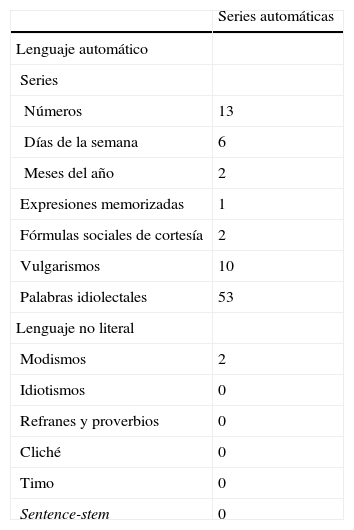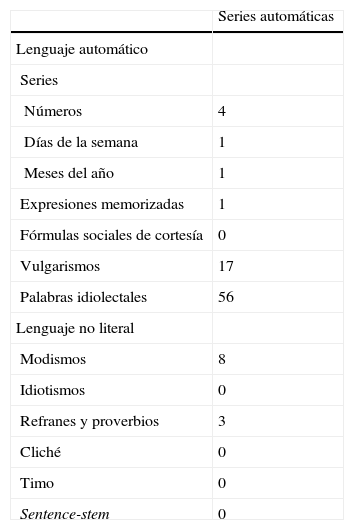Este trabajo ofrece una revisión de las clasificaciones sobre los automatismos en el contexto de enfermos afásicos (fluentes y no fluentes), intentando distinguir los componentes verbales que forman parte de la disociación automático-voluntaria.
ObjetivoA partir de las principales clasificaciones realizadas en lengua inglesa, se establecerá una distinción entre lenguaje automático y lenguaje no literal. Esta distinción será la base para conocer los automatismos que pertenecen a la disociación automático-voluntaria (que llamaremos lenguaje automático) y los que no pertenecen a tal disociación (que llamaremos lenguaje no literal).
PacientesLa clasificación de los automatismos se ejemplificará gracias al corpus PerLa, realizado en la Universidad de Valencia, con cinco afásicos fluentes y cinco afásicos no fluentes.
DesarrolloA partir de la clasificación discutida y a partir del corpus PerLA se ofrecerán ejemplos de lenguaje automático y de lenguaje no literal en enfermos afásicos fluentes y no fluentes. En esta taxonomía se observará que apenas existen diferencias en el habla de estos enfermos en relación con el lenguaje automático, pero sí con el lenguaje no literal.
ConclusionesLa clasificación ofrecida permitirá a los logopedas obtener una base para poder discernir entre qué automatismos pertenecen al lenguaje automático y cuáles no. La distinción entre ambas clases de lenguaje (automático y no literal) por parte de enfermos fluentes y no fluentes es una consecuencia tanto del carácter implícito del lenguaje automático como del denominado “efecto de variación de tareas”.
This article provides a review of classifications of automatisms in the context of aphasic patients (fluent and non-fluent) and attempts to identify the verbal components forming part of automatic-voluntary dissociation.
ObjectiveBased on the main classifications carried out in English, we aimed to distinguish between automatic language and non-literal language and to use this distinction as the basis for identifying the automatisms forming part of automatic-voluntary dissociation (which we call automatic language) and those not forming part of this dissociation (which we call non-literal language).
PatientsAutomatisms were classified using the Perception, Language and Aphasia (PerLA) corpus, constructed at the University of Valencia, with five fluent and five non-fluent aphasic patients.
DevelopmentBased on the classification discussed and the PerLA corpus, we provide examples of automatic and non-literal language in fluent and non-fluent aphasic patients. In this taxonomy, few differences were found in the speech of these patients in relation to automatic language but greater differences were identified in non-literal language.
ConclusionsThe classification proposed could help speech therapists to identify which automatisms belong to automatic language and which do not. The distinction between both classes of language (automatic and non-literal) by fluent and non-fluent patients is a consequence of both the implicit character of automatic language and of the effect of task variation.
Artículo
Comprando el artículo el PDF del mismo podrá ser descargado
Precio 19,34 €
Comprar ahora










